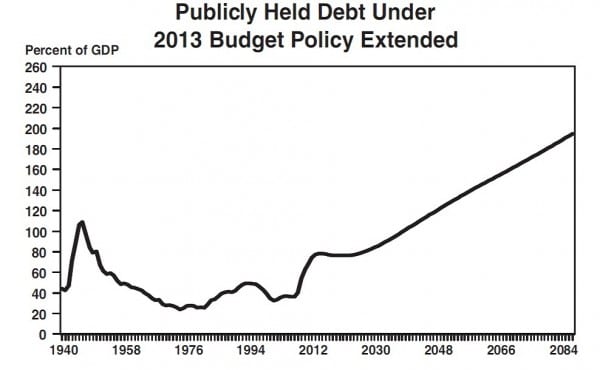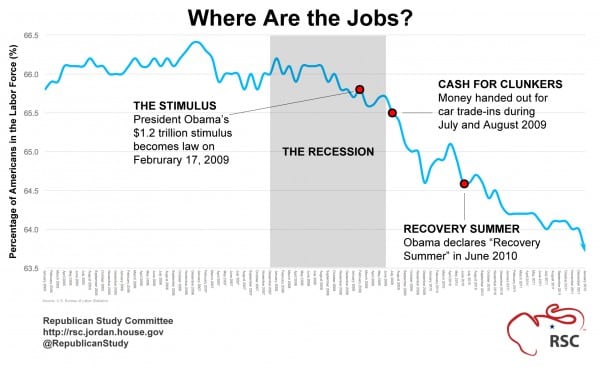Here’s a telling comment:
The drop in employment is unsurprising to those of us in the small business sector where 90% of jobs are created. In 2004 I helped start a company with two partners. We invested $500K of risk capital, put a traditional company infrastructure in place and eventually hired over a dozen people. Why? Because sentiment was positive, HSA plans were inexpensive, and growth a reality. After four years of solid growth, we sold our company to a public company, where we continued to work. In all that time, my proudest moments came from giving young people a career start in life. Many have gone on to work for places such as Symantec, Facebook and Wells Fargo. Today, my partners and I are independent, making good livings — solo. It makes ZERO economic sense for us to start a company again and employ people. The health plan we had is no longer available and coverage is twice as costly. The regulatory burdens are overwhelming and getting worse. We can see only risk on the horizon and little reward to justify that risk. So a dozen bright, talented 20somethings will likely never get the same chance to enter the private workforce.
Here are the two charts that say it all.
[Update a while later]
Some people aren’t seeing the comments at the Powerline post. I see them, but perhaps one has to be logged into Facebook to do so. A good reason not to use FB for comments. Anyway, at least that first comment is available for viewing here.


Where is the comment from? It doesn’t appear at the link.
It’s the first comment in the comments section.
Yeah, I can’t see any comments on powerline either. Powerline uses FB for comments so perhaps something is broken over there at the moment.
Also, Rand I posted a larger comment on this post earlier and it hasn’t shown up yet. Perhaps it is stuck in some kind of spam filter? I know it went through since when I pushed post a second time I got the ‘You already said that’ screen.
I don’t know. I don’t see anything waiting to be moderated. Is it possible to back up and copy and paste it somewhere, and try again?
I dunno either, I tried reposting it again, and still got the “Duplicate comment” screen. I also looked in a couple of other comment threads to see if perhaps I’d accidently posted it there, but I didn’t find it. My comment begins with “I am loathe to read to much into the declining labor participation rate.”
Rand, here’s a link to the text of my failed comment.
http://pastebin.com/0HA9B0tU
Yea, the comments aren’t showing up in Firefox 10 but they do load in IE. Not sure if it’s the Adaware extension that is blocking it. I had added a line in Adaware that block the Facebook “Share” button because apparently that button actually tracks your browsing habits whether you click on it or not.
A helpful add-in for Firefox is the OpenIE tab extension. It lets you right click a page that isn’t displaying properly in Firefox and instantly open it in a new IE window.
I’m using IE8 at the moment, and they aren’t showing up here either, so who knows.
I’m running FF 6.02 in Linux, and they show up fine.
Hmm, somethings wacky. I’m using IE7 and just tried to post a comment over there and it keeps saying I typed the wrong password when I know it’s right because it works when I go to my main Facebook page. *shrug* It’s a mystery.
[Note: this comment is actually from Hal Duston, who was having trouble posting it himself, but for some reason, WP isn’t letting me edit the name.]
I am loathe to read to much into the declining labor participation rate. The civilian labor force participation rate peaked at 67.33% in Feb of 2000, while the employment-population ration peaked at 64.74% in Apr of 2000. Both have been steadily trending down since then. The labor force participation rate hovered just under 60% from 1948 until Jun of 1969 when it crossed over 60% and eventually climbed to the 64.74% peak in Apr of 2000.
The Male Labor Force Participation Rate has been dropping steadily from 86% in 1948 to 70% today. The Female Labor Force Participation Rate climbed from 32% in 1948 to a peak of 60.3 in 2000, and has dropped back to 57.6% today. Separating the gender numbers by race (where available) shows the same pattern.
I am wondering if it is merely returning to historic levels.
Source: http://data.bls.gov/cgi-bin/srgate
Series ID: LNS11300000 — (Seas) Labor Force Participation Rate
LNS11300001 — (Seas) Labor Force Participation Rate – Men
LNS11300002 — (Seas) Labor Force Participation Rate – Women
LNS11300003 — (Seas) Labor Force Participation Rate – White
LNS11300004 — (Seas) Labor Force Participation Rate – White Men
LNS11300005 — (Seas) Labor Force Participation Rate – White Women
LNS11300006 — (Seas) Labor Force Participation Rate – Black or African American
LNS11300007 — (Seas) Labor Force Participation Rate – Black or African American Men
LNS11300008 — (Seas) Labor Force Participation Rate – Black or African American Women
LNS11300009 — (Seas) Labor Force Participation Rate – Hispanic or Latino
All Years
The labor force participation rate should be adjusted for working age population. Baby boomers are retiring (sometimes early) and skewing the statistics.
Here’s a handy document, Age adjustment to labor participation.PDF, published in 2002 and covering 1960 to 2040 (future predicted from demographics). It contains a conversion from the raw BLS labor participation rate to an adjusted rate, creating a flatline participation rate from around 2000 onwards. By comparing the propsed raw numbers to our real ones, the curve could be adjusted so we could get a better look at how much of the decline in participation is due to demographics and how much is due to Obama.
That was also my thought; we have a demographic shift going on, and will for decades, still.
As the boomers age out, it’s no surprise that the percentage of population in the workforce will decrease; it’s not going to do anything else for a while.
Okay, I punched the numbers in my above link into a spreadsheet and eyeballed Instapundit’s graph (I picked January of each year). In my link they took 2000 as the last year of data (with an age-adjustment to match the 1960’s demographics) and their formula converted 2000’s raw 67.2% workforce participation into an age-adjusted 68.2% (1960 demographics). From there they produced data points for 2005, 2010, and 2015. I used linear interpolation to populate their anticipated raw workforce numbers for 2001 .. 2004, 2006 .. 2009, and 2011 .. 2012, giving me the conversion factor they’d use for those years.
Using this conversion factor the age-adjusted (1960) participation rate should end up as 68.2 for every year past 2000.
Here’s what I got for the years covered by Instapundit’s chart. Keep in mind that to match 2000’s labor participation rate, these numbers should each be 68.2
2005 67.2
2006 67.6
2007 68.2
2008 68.1
2009 67.8
2010 67.2
2011 66.7
2012 66.4
What I see is the recovery from the recession that started in Clinton’s last year, hitting the expected 68.2% participation in 2007. This dipped by 0.1% in 2008, when the housing bubble broke and the financial markets were in trouble. Since then we’ve been losing ground rapidly, and are now 1.8% below the labor force participation rate even when corrected for demographic changes. This amounts to 2.63% of the expected workforce, so adding 2.63% to the unemployment rate (current 8.3%) should produce a good measure of real unemployment. That number would be 10.93%, which doesn’t compare favorable to 2007 when the age-adjusted participation rate of 68.2% produced nothing to add to the year’s 4.6% unemployment rate.
But this will likely be offset by the increases in longevity due to medical and nutritional improvements. The ages at which people are retiring has been steadily rising. As a result, this has been causing the number of people in the workforce age 65 and older to actually increase as a percentage of the total workforce. And it’s estimated by 2016 that the number of workers over 65 will continue to increase to double of what it is today.
http://www.diversitybusiness.com/news/diversity.magazine/99200841.asp
I would ignore anything after 2012 on that first chart. The alarming part is the rise during Obama is about the same rate as WW2 but with a much higher GDP. Stossel says we could get balance in ten years if only we capped growth at 2% which appears impossible in the current climate.
Where are the adults in charge?
Re the comment:
Here is something else to consider–the availability of time. As someone thinking of taking the entrepreneur route in the engineering field, I know to make it work I have to be able to be knowledgeable in both the technical side and the business side, or else it just isn’t going to happen. But there is a third side–the government compliance side, and the more that becomes a burden, the less time I have for the other two–especially because the government has a rather forceful way to make sure its needs are met no matter what else is going on.
Governments at all levels simply cannot go around making regulations like every business has a staff of compliance experts waiting at its beck and call, because for the small ones the only guy that can do that without capital expenditure in the early days is the founder. Business is already a field where the sophisitication required as far as knowledge is already, in my opinion, steadily rising to the point where serious in-depth study is needed at the beginning if you did not pursue a business degree in college. I feel that what the rising tide of government regulations is doing is putting another quantum barrier that demands the small business be able to perform with the experience base of a large one, or at least so I think, and often that just might not happen. My personal view is that without pushback, the left will continue to the point, in a manner akin to the recent contraception mandate, that if you are an employer you will be viewed automatically guilty of some kind of crime-in-waiting against employees and no exemptions will be made for company size/revenues. Even though in the early days, on a cash basis, the employee may actually be making more than the employer.
Basically, if I have to start figuring in for a business model, before I even begin, not just current government mandates, but potential changes in those mandates, then at some point it becomes a set of simultaneous equations that takes too much time to solve, time that could be spent doing something else.